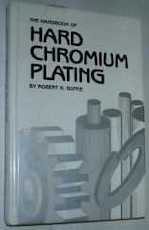
Curated with aloha by
Ted Mooney, P.E. RET

The authoritative public forum
for Metal Finishing 1989-2025

-----
Chrome Plating: Student & industry research Q&A
I'm a university student doing very preliminary research into chrome plating. If anyone has any summaries regarding the process (less than ten typed pages) then I would really appreciate receiving them.
Thanks for your time,
Joshua KuswadiUniversity of New South Wales
1998
Ed. note: We have an "Introduction to Chrome Plating" on line that may be exactly what you're looking for, Joshua. Good luck.
A. See our library and reference books for something you could look up in your own library. I believe that the ASM books have a short description of each process, but I'm not sure. A summary of what? The chemistry, uses of the deposit, wastewater treatment?

Tom Pullizzi
Falls Township, Pennsylvania
⇦ Tip: Readers want to learn from Your Situation 🙂
many readers skip abstract questions.
Q. Can someone tell me the new process out for chrome plating. It is supposed to be safe and environmentally friendly.
Thanks,
Mike Klein1998
A. Hi, Mike. For decorative chrome plating (as opposed to functional hard chromium plating) it is possible to use a proprietary trivalent chromium solution, which obviates the need for hexavalent chromium. That's probably what you heard about. This is available from the major plating process suppliers like Atotech, Enthone, and Macdermid -- but these are generally not 'easier', they are more difficult than conventional chrome plating; and automotive companies have not yet found them fully satisfactory, perhaps because the match is not perfect.
In addition, though, there are substitute platings which suppliers to the hobby plating industry offer -- they are not really chrome plating, but stuff like nickel-cobalt plating, and apparently good enough for hobbyists. Good luck.

Ted Mooney, P.E.
Striving to live Aloha
finishing.com - Pine Beach, New Jersey
Q. Would like to find out data regarding the process of hard chrome plating. Have been approached with perhaps entering into a business arrangement with someone in this area and would like to be able to speak intelligently on the subject. Obviously, I don't know ANYTHING!
Be considerate of my ignorance and don't talk over my head. All I'm wanting is some data on what the actual operation entails.
Thanks
Leonard Uptegrove1998
by Robert K. Guffie

on AbeBooks
(rarely)
or eBay
(rarely)
or Amazon
(affil links)
A. We are visual creatures and I think the first order of business is to tour a hard chrome plating shop.
Hard Chrome Plating is the process of electroplating chromium onto parts (usually hardened steel parts) to give them great hardness, wear resistance, and low friction. Examples would be piston rings, rollers, thread guides, surfaces of molds, internal parts of pumps, gun bores, etc.
It usually involves mechanically preparing the surface via grinding or blasting, then aqueous cleaning, and then plating by immersing the parts in a tank full of chromic acid plating solution.
There is labor and knowledge required in chrome plating. Safe and legal handling of the fumes and liquid wastes is a very big factor. Guffie's Hard Chromium Plating is an excellent short book on the subject. Good luck!
Regards,

Ted Mooney, P.E.
Striving to live Aloha
finishing.com - Pine Beach, New Jersey
Q. I need to know from anyone with any info on how much the US is spending on researching, eliminating, etc., chrome replacements. I'm trying to answer the question "Is the cost worth the risk reduction?" ANY info is needed. Thanks to all.
Provens [last name deleted for privacy by Editor]US Air Force, Ohio
1998
A. It would be a big job, Provens, but you could probably find out how much is being formally spent by contacting the aircraft manufacturers who have several task forces going, the AESF who have periodic seminars on the subject at their conferences, the EPA which funds some of these efforts, and NIST which funds still other efforts.
But you could never begin to assemble all of the informal costs (like time spent on threads here), time spent by engineering teams during planning, time lost to general hand-wringing as owners and managers agonize over what to do, etc.
And the harder question still to me would be how much the overall risk has been reduced, if at all? If additional process maintenance is required for the substitute process (and it certainly is), and an operator dies in the workplace (which they do), what percentage of the 'blame' for his death is attributable to the requisite process control involved in eliminating chromium? Contrariwise, if we are able to eliminate the hexavalent chromium treatment process from the waste treatment system, how do we know that an operator would not have died maintaining it had it still been running?
I won't even get into airplane, car, and train crashes, etc. that could be partially attributable to inferior substitute finishes on a critical component. And, what if the substitute finish is acceptable in the abstract, but in the concrete it is applied poorly with tragic result? Is this totally the blame of the QC system, or is it partially the fault of the engineer who spec'ed it since every one of knows with certainty that more complicated processes will always naturally generate more defects?
And look at thread 1144, where a member of the public has became so terrorized by this drumbeat of chromium paranoia that he wants to treat his parts by dipping them in molten lead instead! He'll be breathing red lead oxide in order to "reduce the risk" to his health! Whose is to blame for such tragedies? The cost of a mutant meme on the loose is simply beyond any calculation.
If we had people directly dieing because of chromium exposure, a risk analysis would be meaningful thing. My personal opinion is that the 'science' of risk analysis applied to situations like chrome elimination, is ludicrous and a perfect textbook example of 'precision without accuracy'.
We need to eliminate immediately the recognizable, common sense, elements of chromium risk: If an operator develops a 'chrome hole', shut down the damned line until we find out exactly what is deficient and how it can be positively corrected. Reduce the PEL until chrome holes and chrome sores are a thing of the past. And forget the rest of this nonsense. Just one guy's overly opinionated opinion.

Ted Mooney, P.E.
Striving to live Aloha
finishing.com - Pine Beach, New Jersey
![]() Ted couldn't have said it better. As for the Provens question, the party I would start with is Paul Shapiro of the EPA, Phone: 202-564-6833. Also, there is a lot of information that could be downloaded from www.nmfrc.org.
Ted couldn't have said it better. As for the Provens question, the party I would start with is Paul Shapiro of the EPA, Phone: 202-564-6833. Also, there is a lot of information that could be downloaded from www.nmfrc.org.
- Fort Collins, Colorado
Ed. note: Please note that this is a 1998 posting. If you managed to locate Paul Shapiro at the EPA 25 years later I don't think he'd want to talk to you about it :-)
Q. I'm a university student doing an essay about the chrome-plating process. Any information anyone had for this matter would be appreciated.
Aris PapageorgiouGreece
1998
A. Hi Aris. Welcome.
Our "Introduction to Chrome Plating", Tom Pullizzi's response to Joshua Kuswadi, and the editorial note, appears equally applicable to your inquiry. After those, you may need to read a book, or at least a chapter, and decide what your subject and thesis will be. If you then get stuck, we'll be happy to try to help you. Good luck.
Regards,

Ted Mooney, P.E.
Striving to live Aloha
finishing.com - Pine Beach, New Jersey
![]() Aris: I agree with Ted Mooney. First read a book. Then, if you find the subject interesting (and it is!), ask a local hard-chrome plating company to work there for a few weeks. There is no better way to understand hard-chrome plating then to experience it yourself. Hard-chrome plating can't be learned from a book. In fact, the hard-chrome plating itself is not the most important subject. It is the pre-treatment of the products that makes the quality of the hard-chromium layer.
Aris: I agree with Ted Mooney. First read a book. Then, if you find the subject interesting (and it is!), ask a local hard-chrome plating company to work there for a few weeks. There is no better way to understand hard-chrome plating then to experience it yourself. Hard-chrome plating can't be learned from a book. In fact, the hard-chrome plating itself is not the most important subject. It is the pre-treatment of the products that makes the quality of the hard-chromium layer.
If you like, you can do a practical period with our company in the Netherlands :-)
Success,
Tim JaarsmaHardchroom Techniek Nederland - Hengelo, The Netherlands
by Clarence H. Peger
(You're unlikely to find this for sale ... but copies are in select libraries)

from AbeBooks
* rarely available *
or eBay
* rarely available *
or
Amazon
* rarely available *
(affil links)
Q. Hello there,
I've been working for a hard chrome plater since the last 5 years and I am interested in sharing notes with anybody interested. Topics could range from difficulties in electrodeposition on hardened steels to new technologies.
Solomon Mordecai- Mumbai, Maharashtra
A. Hi Solomon. That's exactly what this site is about! But we don't do it as a private matchmaking or pen-pal club and hooking-up pairs of individuals, but by public participation. We have all the room on the world for any questions you wish to ask or any notes you wish to share.
Luck & Regards,

Ted Mooney, P.E.
Striving to live Aloha
finishing.com - Pine Beach, New Jersey
9th Edition, Vol. 5
"Surface Cleaning, Finishing & Coating"

on AbeBooks
or eBay or
Amazon
(affil links)
Q. While I am aware that learning anything is 10% book and 90% application, (I am a JOURNEYMAN [Foundry] MOLDER,) and there still has to be a starting point. I am interested in learning about (entry level) electroplating. What I am after is basic do-it-yourself, in the garage type of plating, small parts, not in a production situation. I need information on metals that can and cannot be plated, how to set up a "garage" operation, build the necessary equipment, voltages and current to use. In short - I don't know squat about the subject that I want to learn.
Where do I start and what book(s) am I looking for? Any assistance that you might offer would be greatly appreciated.
USN (Ret) PORT ANGELES Washington
1998
Q. Looking to start up a chrome plating business a.s.a.p.
Kenneth C [last name deleted for privacy by Editor]2000
A. Dan and Ken, you may be able to do some type of bright plating in your garage, like nickel or tin or zinc, but there is no starting point for garage chrome plating. Chromium is a very highly regulated carcinogen. The stuff that made Erin Brockovich
[affil link to Amazonaffil links] a household name; the stuff you do chrome plating with is very highly concentrated (28 oz/gal+) hexavalent chromium.
One guy I know of started a chrome shop in a garage in Odessa Texas, and ended up becoming a Superfund site, embroiled in a lawsuit that has dragged on for years, with legal costs alone in the millions of dollars and counting. Another guy I know in Pennsylvania started plating in his garage and was in the penitentiary last time I heard of him, because the cost of legal disposal would have meant losing his house, and he was caught illegally disposing of waste.
There are people who disagree with me, of course, but there are so many disposal issues, safety issues, regulatory issues, training issues, etc. that "starting small" in chrome plating is rather like starting lunar landings with small payloads. You must start in an industrial setting -- not a residential garage -- sorry. If practical, please try to work in a chrome plating shop for a summer before committing yourself to it and you'll understand. Good luck.

Ted Mooney, P.E.
Striving to live Aloha
finishing.com - Pine Beach, New Jersey
Q. You have a great web site. I've enjoyed reading many of the threads posted, especially your responses. Your approach to personal safety and the environment is assuring.
Because of this, your advice would be appreciated, even if it might not be what I want to hear. Fishing is my main vice in life and one of my favorite pastimes is making my own fishing lures. I would like to know how to put a silver/chrome type finish and a gold/brass type finish on lead jig heads. I have heard of people who do this locally but they seem to be rather secretive about it. Perhaps they're selling their product to the local shops and don't want competition. Perhaps these people don't even exist. I really don't know anything about plating.
Thank you for taking the time to answer so many letters. They are an education in themselves.
Bob Robilliard- Kenora, Ontario, Canada
2002
A. Thanks for the kind words, Bob. There are some kinds of plating that absolutely should not be done except by trained personnel in a properly regulated and equipped industrial facility. That would include chrome plating because the fumes are carcinogenic and the waste products are a very powerful and a very mobile contaminant. It would include any plating that requires cyanide (brass plating or silver plating for example) because cyanide is such a powerful and dangerous poison. It would include cadmium plating because it is a chronic poison and it is vital that cadmium plated parts don't accidentally get used for food service or get welded. It would include any plating that requires hydrofluoric acid because that stuff is just so terribly nasty. I think there are few people who would disagree with me on the above prohibitions.
But what is much hotly debated is whether safer kinds of plating (or anodizing) are permissible in a casual environment. If you are not selling anything, only doing it for personal use, and you are careful, and doing it in very small volumes, and you wear PPE, some people say that although there are hazards, they're not out of proportion with the hazards of other hobbies.
I haven't seen these silvery & brassy finishes on lead lures so I just don't know if it's really plating (possibly nickel plating and nickel plating followed by brass-tone lacquering) or whether it's just a paint with metal flakes in it. But in general you need hydrofluoric acid to activate lead for plating (if they are really lead), and that is one of the very few chemicals that scares professionals. So, you might look into "chrome-look paint" instead; it has greatly improved in recent years and only a real pro could tell the difference from a few paces. Alternately, you might try lead-free lures so that hydrofluoric acid isn't required. Best of luck!

Ted Mooney, P.E.
Striving to live Aloha
finishing.com - Pine Beach, New Jersey
Q, A, or Comment on THIS thread -or- Start a NEW Thread

